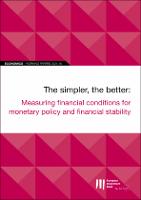EIB Working Paper 2021/10 - The simpler, the better
Measuring financial conditions for monetary policy and financial stability
| dc.contributor.author | European Investment Bank | |
| dc.date.accessioned | 2021-11-16T05:31:11Z | |
| dc.date.available | 2021-11-16T05:31:11Z | |
| dc.date.issued | 2021 | |
| dc.identifier.uri | https://library.oapen.org/handle/20.500.12657/51525 | |
| dc.description.abstract | In this paper we assess the merits of financial condition indices constructed using simple averages versus a more sophisticated alternative that uses factor models with time varying parameters. Our analysis is based on data for 18 advanced and emerging economies at a monthly frequency covering about 70% of the world’s GDP. We assess the performance of these indicators based on their ability to capture tail risk for economic activity and to predict banking and currency crises. We find that averaging across the indicators of interest, using judgmental but intuitive weights, produces financial condition indices that are not inferior to, and actually perform better than, those constructed with more sophisticated statistical methods. | |
| dc.language | English | |
| dc.rights.uri | Copyright held by content provider | |
| dc.subject.classification | thema EDItEUR::K Economics, Finance, Business and Management::KF Finance and accounting::KFF Finance and the finance industry | en_US |
| dc.subject.other | Business & Economics | |
| dc.subject.other | Finance | |
| dc.title | EIB Working Paper 2021/10 - The simpler, the better | |
| dc.title.alternative | Measuring financial conditions for monetary policy and financial stability | |
| dc.type | book | |
| oapen.identifier.doi | https://doi.org/10.2867/149278 | |
| oapen.relation.isPublishedBy | 66479d04-7b84-49c0-9a4d-db552a3ecc71 | |
| oapen.relation.isFundedBy | b818ba9d-2dd9-4fd7-a364-7f305aef7ee9 | |
| oapen.relation.isbn | 9789286150883 | |
| oapen.collection | Knowledge Unlatched (KU) | |
| oapen.imprint | European Investment Bank | |
| oapen.identifier | https://openresearchlibrary.org/viewer/cd47dcef-6165-4756-b35c-f23241b2e7bb | |
| oapen.identifier.isbn | 9789286150883 |

